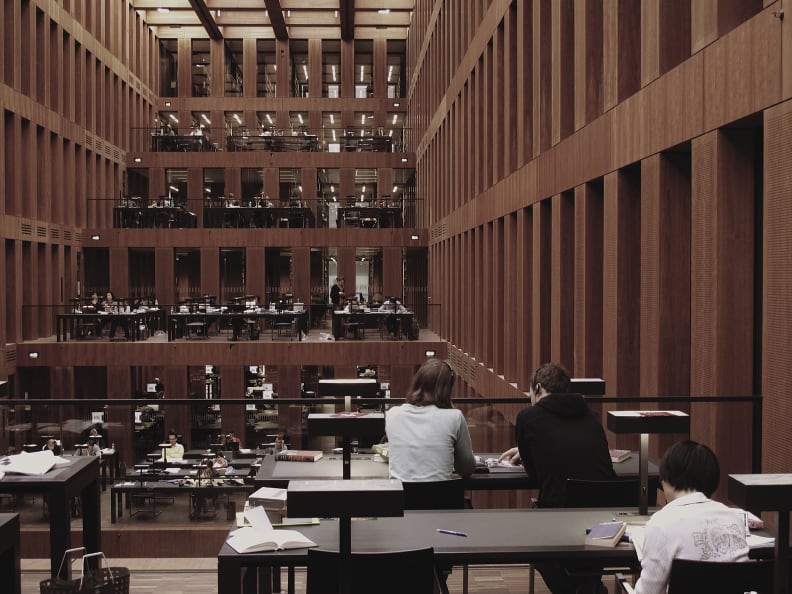
Ant Hampton and Tim Etchells, 2010–2011
Various libraries: Buenos Aires, Berlin, London, Warsaw, Stockholm, Copenhagen.
No-one comes to a library to stay there.1
— Ant Hampton
English artists Ant Hampton and Tim Etchells collaborated for the first time on The Quiet Volume, in which they explore the social and imaginative space created within a library. The work, on iPod, instructs the audience through a delicate performance in which their thoughts collide with the performer’s voice and the movement of pages and shared reading create an intimate escape.
On a sleepy Saturday afternoon I arranged to meet Ant Hampton at the library of the Bishopsgate Institute across from Liverpool Street Station in London. After following him down a corridor I am given an iPod and led through a door to a small and beautiful library. Once inside I am taken to a corner and asked to sit in front of a pile of three books and a notebook. Beside me another participant sits at an identical set of books and between us is a book of photographs titled Parallel Cities.
The work begins with a gentle voice telling us that, for a place usually associated with the preservation of silence, the library seems more a place for the collection of sounds. The word ‘sounds’ resonates as my awareness becomes attuned to the other readers, chairs scraping, an intake of breath, rustling paper, fingers tapping keyboards. The voice continues with further instructions: we are asked to read from the notebook, consider our hands, share the book with our fellow reader and consider the time and place of this room — its shelves and books — as well as the many other times and places represented within the three books in front of us.
Through the voice on the iPod and the instructions in the notebook the artists ask us to consider reading as an activity which allows time to become more flexible; the mind moving forwards and backwards and across the space and time of here and now, and the space-time of the page. As the voice slips in and out of phase with our own reading a disjunction between the two emerges. The work’s quiet achievement is to attenuate the multiple timeframes that we experience as we read and to enable these to coexist in our consciousness, as they are artfully woven in and out of each other. I am reminded of Russian philosopher M M Bakhtin’s definition of the chronotope, (a term borrowed directly from Einstein’s theory of relativity, which literally means ‘space time’): ‘in the literary chronotope spatial and temporal indicators are fused into one carefully thought out concrete whole. Time, as it were, thickens, takes on flesh, becomes artistically visible; likewise space becomes charged and responsive to the movements of time, plot and history’.2 In this work, the artists manage to unpick time from space for the purpose of placing us more directly in the present. As we become aware of these distinct units, time empties of literary purpose and our internal voice performs a concertina-like movement between here and there. As Tim Etchells states: ‘This now of the page is what grips me — the present moment, this one, summoned here with this arrangement of marks/code, ink/pixels, letters and word.’3
The Quiet Volume reveals the expanded architecture of the library through an upside down, sideways and round about reading of the three seemingly unconnected books in front of us. Each page draws your thinking, via a different route, to subjects that take on new connections within the frame of the performance. As we read, relations are formed between snow, holes, whiteness, blindness, travelling, reading and not being able to read. You begin to wonder: in which city did this take place? In which time? This reading, shaken and unbalanced, becomes a metaphor for the library as a porous, shifting place in which all places are possible all at once. In a time when libraries across England are closing their doors and librarians are having to reconsider their roles in a changing technological landscape, this work defines the library as a place of slippage between the immaterial stuff of imagination and the materiality of hands on paper, letters on pages and books on shelves. The library is celebrated as a portal to travel to everywhere and anywhere in the world and as a place from which other places are conjured.
The Quiet Volume took place in libraries across the world for the Ciudades Parralelas or Parallel Cities festival, an itinerant yet ‘site specific’ performance festival curated by Stefan Kaegi and Lola Arias with further support from Vooruit Arts Centre, Belgium.
Madeleine Hodge is an artist, writer and researcher currently living in London.
